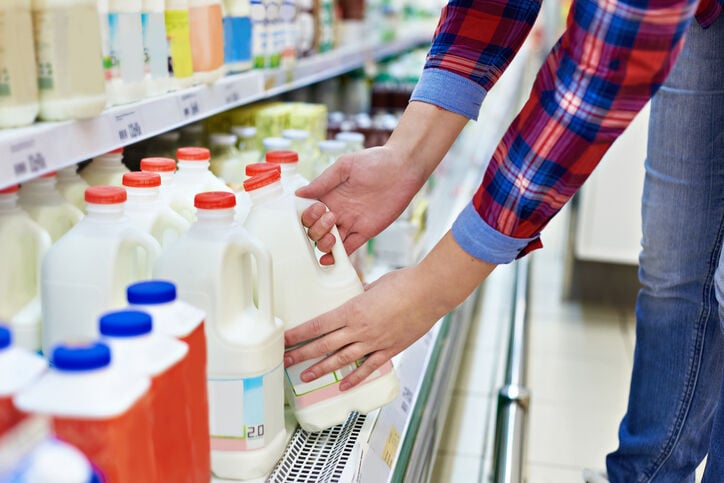A bump in fluid milk sales in the U.S. this year bodes well for dairy farmers and could indicate changing consumer attitudes about the healthful qualities of milk.
According to an Oct. 23 report from the National Milk Producers Federation, total fluid milk consumption in August was up 1.6% from one year earlier, while year-to-date consumption was up 0.7%.
The report called the increase in demand, along with a decline in domestic production, “unusual when compared with decades-long trends.”
Attendees of the Pennsylvania Farm Show and the Keystone Farm Show voiced their support for putting whole milk back in schools, but legislators are still stalled on the issue.
Domestic consumption of yogurt, butter, fluid milk and cheese also grew more rapidly than the U.S. population.
What is causing the increase, and will the trend continue?
Jayne Sebright, executive director of Pennsylvania's Center for Dairy Excellence, said new milk product innovations along with consumers becoming more health conscious are among the reasons for the sales boost.
This year marks the first increase in fluid milk consumption since 2020 when the Covid-19 pandemic resulted in more families eating at home, and food box deliveries included gallons of milk, she said.
“That was just a blip” in what had been a downward trend in fluid milk consumption since 2009, she said.
But this year’s growth appears to be more than a blip.
“There’s a rising interest in health and fitness,” Sebright said. That includes more people turning to milk as a recovery or fitness beverage.
Changing perception about the importance of fats in the diet is another factor, with more Americans developing a “love affair with natural fats,” she said.
Sebright also believes innovations such as lactose-free and enhanced-protein milk products along with trendier packaging are helping to attract more milk drinkers.

A 97 Milk sign in Dayton, Virginia is seen in this file photo. Educational efforts like this could be helping to drive an upward trend in fluid milk consumption.
Jackie Behr of the 97 Milk promotion campaign is confident that educational efforts are helping as well.
“People are becoming more educated,” Behr said. “I think consumers have been embracing the farm-to-table movement. They want whole foods, not processed foods.”
Behr and others started 97 Milk in 2019 to help meet what they saw as a need for more consumer education on the healthful qualities of whole milk. The “97” refers to whole milk being about 97% fat-free.
“Our goal has always been to reach out to consumers and get them the facts,” she said. “I talk to people across the country and even internationally.”
The campaign began in southeastern Pennsylvania and has spread to multiple states with about 20,000 followers currently on social media, she said.
Chuck Nicholson, a dairy economist at the University of Wisconsin, sees the increase as a shift in the kind of products people are buying without necessarily indicating a sustained upward trend.
In a Nov. 12 email, Nicholson wrote that the rise in fluid milk consumption from August 2023 to August 2024 mainly comes from an increase in the “Other Fluid Milk Products” category, which includes eggnog, drinkable yogurt, miscellaneous fat-reduced milk, Lactaid products and other fluid milk products.
While year-to-date whole milk sales are up 2.4% in 2024 compared to 2023, many other fluid milk product categories have decreased, he noted.
"To me, this suggests that consumers are shifting among the product categories rather than increasing their consumption overall," Nicholson wrote. "Although this recent tick upward in overall sales is welcome and a change from long-time patterns, I think it is too early to say that it represents a shift to a new trend of sustained increases in total fluid milk sales."
The NMPF report also noted a decrease in U.S. milk production compared to last year.
American Dairy Association North East helps farmers tell their story with consistent messaging that fosters consumers’ understanding of dairy.
August production was 0.1% lower than in August of 2023, marking the 14th consecutive month in which production was lower than the corresponding month of the previous year.
The same 14-month period saw a 1.2% increase in milkfat production.
Monthly estimates of this year’s total production showed steady reductions from June to September, according to the report.
However, the October estimate showed the production decline slowing considerably, projecting 2024 total milk production at 225.8 billion pounds, just below the 226.4 billion pounds reported in each of the past two years.
While milk prices paid to farmers remain relatively strong, drops in butter and cheese cash markets from September to October caused the World Agricultural Supply and Demand Estimates to project a $0.25 all-milk price decline in 2024 from its September estimate.
WASDE lowered its 2024 average all-milk price estimate from $23.05 to $22.80 per hundredweight.
Sebright and Behr are hopeful that milk consumption will continue its upward trend.
Dairy stakeholders and legislators pushing for whole milk to be included in federal dietary guidelines is an ongoing campaign that could help make a difference.
“I’m always optimistic,” Sebright said. “This trend toward health and fitness is only going to continue to grow.”
Even so, “I think there’s always more we can do,” she said.
This article has been updated from its original version to include comments from Chuck Nicholson.






